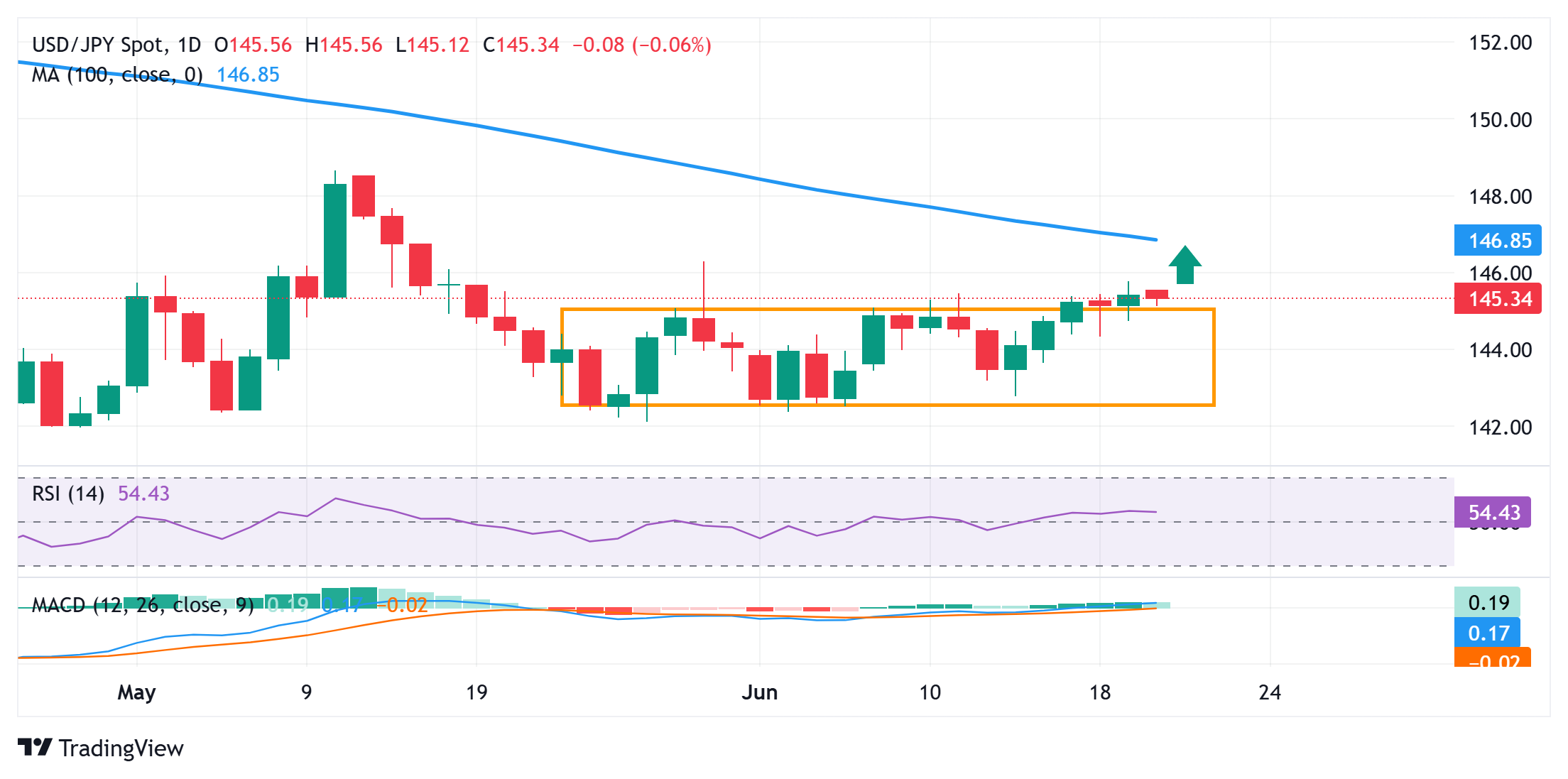JPY struggles to capitalize on domestic inflation data-inspired uptick
- The Japanese Yen attracts some buyers as strong domestic CPI reaffirms BoJ rate hike bets.
- Trade uncertainties and rising geopolitical tensions also benefit the JPY’s safe-haven status.
- A weaker USD contributes to the USD/JPY pair’s retracement slide from the monthly high.
The Japanese Yen (JPY) edges higher against its American counterpart during the Asian session on Friday and moves away from the monthly low touched the previous day. Government data released from Japan showed that the annual National Consumer Price Index (CPI) remained well above the Bank of Japan’s (BoJ) target of 2% in May. This reaffirms market bets that the BoJ will hike interest rates again and turns out to be a key factor that provides a modest lift to the JPY.
Meanwhile, persistent trade-related uncertainties and a further escalation of geopolitical tensions in the Middle East continue to weigh on investors’ sentiment, which further underpins the safe-haven JPY. Moreover, a modest fall in US Dollar (USD) drags the USD/JPY pair back closer to the 145.00 psychological mark. However, expectations that the BoJ could stay on hold until Q1 2026 and the Federal Reserve’s (Fed) hawkish pause earlier this week could limit losses for the pair.
Japanese Yen draws support from stronger domestic consumer inflation figures, safe-haven buying
- The Japan Statistics Bureau reported this Friday that the headline National Consumer Price Index (CPI) rose by 3.5% YoY in May, compared to the previous reading of 3.6%. Meanwhile, the National core CPI, which excludes volatile fresh food prices, picked up from the 3.5% YoY rate in April and grew 3.7% last month – marking the highest level since January 2023.
- Further details revealed a core reading that excludes both fresh food and energy prices and is closely watched by the Bank of Japan as a gauge of underlying inflation rose 3.3% YoY in May from 3.0% in the prior month. Stronger CPI prints pointed to broadening inflationary pressures in Japan and gives the BoJ more impetus to hike interest rates in the coming months.
- However, the BoJ earlier this week signaled its preference to move cautiously in normalizing still-easy monetary policy and decided to slow the pace of reduction in its bond purchases from fiscal 2026. Adding to this, the gloomy economic outlook and the uncertainty over US President Donald Trump’s tariffs suggest that the BoJ could forgo hiking interest rates in 2025.
- The Federal Reserve, on the other hand, projected two rate cuts by the end of 2025, though officials forecast only one 25-basis points rate cut in each of 2026 and 2027. Furthermore, seven of the 19 policymakers indicated they wanted no cuts this year, up from four in March, amid persistent worries that the Trump administration’s tariffs could push up consumer prices.
- Meanwhile, Trump earlier this week said that tariffs on the pharma sector are coming soon. This adds a layer of uncertainty in the markets ahead of the July 9 deadline for higher reciprocal US tariffs. Adding to this, rising geopolitical tensions continue to weigh on investors’ sentiment, which, along with relatively hawkish BoJ expectations, underpins the Japanese Yen.
- On the geopolitical front, the Iran-Israel conflict enters its eighth day as Trump weighs US involvement in the war. According to the White House, Trump said that he will allow two weeks for diplomacy to proceed before deciding whether to launch a strike on Iran. European foreign ministers are slated to meet Iranian officials on Friday and press them to de-escalate.
USD/JPY could attract dip-buyers; the overnight breakout through a short-term range remains in play

From a technical perspective, the USD/JPY par’s back-to-back close above the 145.00 psychological mark this week, along with the overnight move beyond the previous monthly peak, around the 145.45 area, was seen as a fresh trigger for bulls. Moreover, oscillators on the daily chart have just started gaining positive traction and suggest that the path of least resistance for spot prices remains to the upside. Hence, any further pullback could be seen as a buying opportunity near the 144.50-144.45 area. This, in turn, should help limit losses near the 144.00 round figure. A convincing break below the latter, however, would negate the positive outlook and shift the near-term bias in favor of bearish traders.
On the flip side, the 145.75 area, or the monthly top touched on Thursday, could act as an immediate hurdle ahead of the 146.00 mark. This is closely followed by the May 29 peak, around the 146.25-146.30 region, above which the USD/JPY pair could aim to challenge the 100-day Simple Moving Average (SMA), currently pegged just ahead of the 147.00 round figure. Some follow-through buying might then pave the way for a move towards the 147.40-147.45 intermediate hurdle en route to the 148.00 mark and 148.65 region, or the May monthly swing high.




